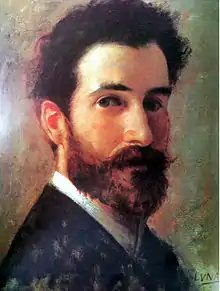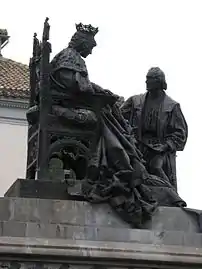Mariano Benlliure
Mariano Benlliure (8 September 1862 – 9 November 1947) was a Spanish sculptor, who executed many public monuments and religious sculptures in Spain, working in a heroic realist style.[2]
Mariano Benlliure y Gil | |
|---|---|
 | |
| Born | Mariano Benlliure y Gil September 8, 1862 |
| Died | November 9, 1947 (aged 85) |
| Known for | Sculpting, Painting |
| Movement | Heroic realism, Neoclassicism |
Life and works
He was born in the Lower Street of the Carmen neighborhood of Valencia. His earliest sculptures featured bullfighting themes,[3] modeled in wax and cast in bronze. At the age of thirteen he showed a wax modello of a picador at the Exposición Nacional de Bellas Artes, 1876. Pursuing the thought of becoming a painter, he went to Paris his expenses paid by his master, Francisco Domingo Marqués. A trip to Rome in 1879, revealing at first hand the sculptures of Michelangelo convinced him to be a sculptor. In 1887 he established himself permanently in Madrid, where in that year's Exposición Nacional his portrait sculpture of the painter Ribera won him a first-prize.[2]
Benlliure's style is characterized by detailed naturalism allied to an impressionistic spontaneity. His portrait busts and public monuments are numerous, and include:
- the tomb of Práxedes Mateo Sagasta in the Pantheon of Illustrious Men, Madrid
- monument to José de San Martín, Lima, Peru
- the monument to Álvaro de Bazán, Plaza de la Villa, Madrid.[4]
- the monument to Isabella the Catholic,[5] Granada
- the monument to General Cassola,[6] Parque del Oeste, Madrid
- the monument to Maria Christina of Bourbon, Madrid
- the bronze equestrian statue of the monument to Alfonso XII, in Madrid's El Retiro, the centerpiece of a memorial designed by architect José Grases Riera.
- the monument to Agustina de Aragón, in Zaragoza.
- the monument to Castelar, in Madrid.
- the monument to Arsenio Martínez Campos, in El Retiro.[7]
- the monument to Miguel Primo de Rivera, in Jerez de la Frontera.[8]
- the monument to Antonio Maura, in Palma de Mallorca.[9]
- the monument to Cuba, in El Retiro, with help from Miquel Blay, Francisco Asorey and Juan Cristóbal (completed by 1930, unveiled in 1952).
He was depicted on the Spanish 500 ptas banknote in the 1950s, with his sculpture "Sepulcro De Gayarre en el Roncal" on the reverse.
His brothers José and Juan Antonio were also painters.
Works
_01.jpg.webp) Monument to Álvaro de Bazán, 1891 (Madrid)
Monument to Álvaro de Bazán, 1891 (Madrid) Monument to Queen Elizabeth and Columbus, 1892 (Granada)
Monument to Queen Elizabeth and Columbus, 1892 (Granada)_02.jpg.webp) Monument to Emilio Castelar, 1908 (Madrid)
Monument to Emilio Castelar, 1908 (Madrid).jpg.webp) Equestrian statue of Alfonso XII, 1928 (Madrid)
Equestrian statue of Alfonso XII, 1928 (Madrid)
References
- Santiago Albano Pilar (1980). Juan Luna, the Filipino as painter. Eugenio Lōpez Foundation. p. 56.
- España es Cultura. "Mariano Benlliure". Ministry of Education, Culture and Sport, Government of Spain. Retrieved December 4, 2014.
- "Neoclassicism: Mariano Benlliure". Spanish Arts. 2011. Retrieved December 4, 2014.
- Gómez, Pablo (24 January 2016). "Tierno Galván versus Álvaro de Bazán". La Razón.
- Romero-Sánchez, Guadalupe; Marfil-Carmona, Rafael (2020). "La imagen de la mujer en el patrimonio urbano de Granada. El espacio público de la ciudad como «escenario comunicativo»" (PDF). Revista Internacional de Investigación en Comunicación aDResearch ESIC. 22 (22): 202. doi:10.7263/adresic-022-11.
- Pastor Mateos, Enrique (1977). "Mariano Benlliure, en Madrid y en la vía pública" (PDF). Villa de Madrid. Madrid: Ayuntamiento de Madrid. XV (54): 30. ISSN 0042-6164.
- "El monumento a Martínez Campos, de Benlliure, Bien de Interés Cultural". Telemadrid. 22 November 2013.
- Reyero, Carlos (2013). "Benlliure monumental". Mariano Benlliure. El dominio de la materia (PDF). p. 109. ISBN 978-84-451-3458-0.
- "Anexo: Índice de monumentos de Mariano Benlliure". Mariano Benlliure. El dominio de la materia (PDF). Madrid & Valencia: Dirección General de Patrimonio Histórico de la Comunidad de Madrid; Consorcio de Museos de la Comunitat Valenciana. 2013. pp. 336–337. ISBN 978-84-451-3458-0.
| Wikimedia Commons has media related to Mariano Benlliure. |